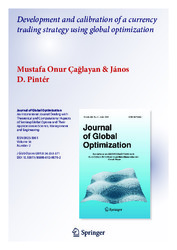Development and calibration of a currency trading strategy using global optimization
| dc.contributor.author | Çağlayan, Mustafa Onur | |
| dc.contributor.author | Pinter, Janos D. | |
| dc.date.accessioned | 2014-07-04T12:26:43Z | |
| dc.date.available | 2014-07-04T12:26:43Z | |
| dc.date.issued | 2013-06 | |
| dc.identifier.issn | 1573-2916 | |
| dc.identifier.uri | http://hdl.handle.net/10679/440 | |
| dc.identifier.uri | http://link.springer.com/article/10.1007%2Fs10898-012-9879-2 | |
| dc.description.abstract | We have developed a new financial indicator—called the Interest Rate Differentials Adjusted for Volatility (IRDAV) measure—to assist investors in currency markets. On a monthly basis, we rank currency pairs according to this measure and then select a basket of pairs with the highest IRDAV values. Under positive market conditions, an IRDAV based investment strategy (buying a currency with high interest rate and simultaneously selling a currency with low interest rate, after adjusting for volatility of the currency pairs in question) can generate significant returns. However, when the markets turn for the worse and crisis situations evolve, investors exit such money-making strategies suddenly, and—as a result—significant losses can occur. In an effort to minimize these potential losses, we also propose an aggregated Risk Metric that estimates the total risk by looking at various financial indicators across different markets. These risk indicators are used to get timely signals of evolving crises and to flip the strategy from long to short in a timely fashion, to prevent losses and make further gains even during crisis periods. Since our proprietary model is implemented in Excel as a highly nonlinear “black box” computational procedure, we use suitable global optimization methodology and software—the Lipschitz Global Optimizer solver suite linked to Excel—to maximize the performance of the currency basket, based on our selection of key decision variables. After the introduction of the new currency trading model and its implementation, we present numerical results based on actual market data. Our results clearly show the advantages of using global optimization based parameter settings, compared to the typically used “expert estimates” of the key model parameters. | en_US |
| dc.language.iso | eng | en_US |
| dc.publisher | Springer Science+Business Media | en_US |
| dc.relation.ispartof | Journal of Global Optimization | |
| dc.rights | openAccess | |
| dc.title | Development and calibration of a currency trading strategy using global optimization | en_US |
| dc.type | Article | en_US |
| dc.description.version | post-print | |
| dc.peerreviewed | yes | en_US |
| dc.publicationstatus | published | en_US |
| dc.contributor.department | Özyeğin University | |
| dc.contributor.authorID | (ORCID 0000-0002-8598-4269 & YÖK ID 21940) Çağlayan, Mustafa | |
| dc.contributor.authorID | (ORCID & YÖK ID 202094) Pinter, Janos | |
| dc.contributor.ozuauthor | Çağlayan, Mustafa Onur | |
| dc.contributor.ozuauthor | Pinter, Janos D. | |
| dc.identifier.volume | 56 | |
| dc.identifier.issue | 2 | |
| dc.identifier.startpage | 353 | |
| dc.identifier.endpage | 371 | |
| dc.identifier.wos | WOS:000320117100011 | |
| dc.identifier.doi | 10.1007/s10898-012-9879-2 | |
| dc.subject.keywords | Currency trading model | en_US |
| dc.subject.keywords | IRDAV financial indicator | en_US |
| dc.subject.keywords | Aggregated risk metric | en_US |
| dc.subject.keywords | Excel model implementation | en_US |
| dc.subject.keywords | Lipschitz global optimizer (LGO) solver engine | en_US |
| dc.subject.keywords | Global optimization by excel-LGO | en_US |
| dc.subject.keywords | Numerical results | en_US |
| dc.identifier.scopus | SCOPUS:2-s2.0-84879030242 | |
| dc.contributor.authorMale | 2 | |
| dc.relation.publicationcategory | Article - International Refereed Journal - Institutional Academic Staff |
Files in this item
This item appears in the following Collection(s)
Share this page



